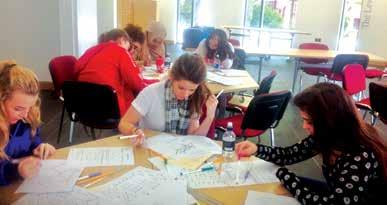
4 minute read
Mathematics
Mathematical Musings
The Maths department has had another busy year with many successes and interesting events throughout. The Maths and Physics Secondary liaison day, organised by Mr Wrigley, was a great success. Year 11 pupils from the community (including our own in the Girls’ and Boys’ Divisions) were invited to attend an introductory morning, applying advanced Mathematics and Physics. Pupils were shown how their mathematics could be used in the creation of games such as Angry Birds. They were also treated to a lecture by Dr Mark Lewney on “The Maths and Physics of the Rock Guitar”, which gave insight into String Theory. Invited speakers this year also included Dr Charles Warkden who gave a very interesting and topical lecture on how the Engima machine was able to crack German Codes during the Second World War.
Pupils that took part in the annual trip to the Maths Inspiration Lectures in Manchester heard talks from a variety of speakers. Dr Hannah Fry discussed the mathematical links and ‘hidden connections’ on social networking sites and how these were utilised for crime prevention, detection and commercial purposes. Other talks looked at ‘Patterns and Predictions’ and ‘why emotion, art and mathematics can go hand in hand despite the stereotypes’. Year 6 pupils from the wider community were invited into School to compete in the team challenge event. Sixteen teams of four combatted their way through a number of mathematical challenges set by Mr Wrigley, with Christchurch Primary being the eventual winner. Following on from last year’s success with the GCSE Further Maths examination, a large number of girls have been studying this extra GCSE during lunchtime sessions organised by Miss Kelly. We wish them all well for the forthcoming examination. The five week Shine course devised and presented by Miss Reynolds, gave Year 9 pupils from within the local community, the opportunity to apply new mathematical skills to real life contexts. The group was tasked with working out the most cost effective method for wiring up the University of York for superfast broadband, using a variety of optimisation algorithms and processes. Yet again, our Sixth Form girls have given their time generously as Maths mentors for the younger pupils, organised by Mrs Gilding. This year, over forty pupils volunteered as Maths hub or one to one mentors, and we thank them for their efforts and time.
In addition, two Year 11 pupils, Emma Rayner and Shavani Manoharan acted as mentors for pupils in Hesketh House. Nicola Li, Milly Wood, Sharon Daniel and Emily Rajbhandari represented the Girls’ Division in the UKMT Junior Team Challenge. They gained a credible 7th place in this year’s regional final competition. Miss Kelly was very pleased with the girls’ efforts. Girls’ Division pupils competed well in all this year’s UKMT challenges. There are too many girls to mention here, but of particular note are Nicola Li, who qualified for the prestigious Hamilton Olympiad, Francesca Adams, Imaan Bhuta and Rhianna Jones who all qualified for the Pink Kangaroo and Mahnoor Raza, Chloe Tsang and Sharon Daniel who qualified for the Junior Kangaroo.
The Rock Doctor Spread Your Wings

We all familiar to our dating system 850BC and 2015AD and understand the meaning of BC and AD but what if time was defined by mathematics?
Mrs Hayes has a few suggestions to make you think: • BC and AC – “before calculators” and “after calculators”.
Just how did students manage before they had use of a calculator? Those old enough to remember will have fond recollections of the battered copies of their “log tables” or their cherished “slide rule”.
Question – What year were calculators first used in Mathematics examinations? • BD and AD - “before decimalisation” and
“after decimalisation”.
Can you imagine using a - money system of “£ sh d” in which there were 12 pence in a shilling and 20 shillings in a pound. - mass system of “st lb oz” in which there were 16 ounces in a pound and 14 pounds in a stone.
- distance system of “yd ft ins” in which there were 12 inches in a foot and 3 feet in a yard. Question – What year was the decimal system first used in Mathematics examinations? • NL and WL - “narrow lined” and “wide lined”.
Historically, narrow lined paper was usually used in Mathematics lessons. Three possible suggestions for this could be - written solutions are easier to read if they are written on alternate lines and narrow lined paper would mean less paper is wasted. - fractions look more like fractions when the numerator and denominator are written on two lines and are close together. - there is more chance of a complete solution fitting on one side of paper! Question – What year did a student first ask Mrs Hayes if they could use wide lined paper in her lessons?










